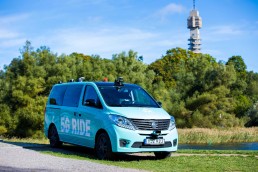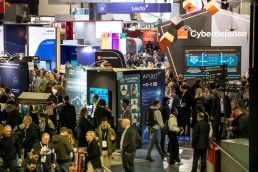Semiconductor Arena
Image credit: TeraSi
Semiconductor Arena: A new platform for Sweden’s growing chip sector
The challenge
The global demand for semiconductors is rising fast. Across Europe, countries are investing to secure supply, build capacity, and reduce reliance on external producers. The goal: to strengthen Europe’s resilience in a technology that powers nearly all modern systems.
In Sweden, the need to boost domestic production and innovation efforts has become increasingly clear since the COVID-19 pandemic. When global supply chains were disrupted, Swedish companies felt the impact immediately. That period exposed structural gaps — from limited infrastructure and restricted access to production facilities, to weak links between industry, academia, and research. Looking ahead, the sector also faces a generational shift, making it critical to attract new talent and pass on expertise.
In Kista, targeted efforts are now being made to close these gaps and build a stronger, more connected semiconductor ecosystem.
Semiconductor Arena
Led by Kista Science City, KTH, RISE and STING, Semiconductor Arena is a new platform for advancing Sweden’s chip capabilities. By offering shared resources and meeting places for startups, researchers, and established companies alike, the Arena supports new innovation constellations and helps accelerate the path from research to commercialization.
A key ambition is to make Electrum Laboratory a more open and social hub for the industry. It will serve as a space for showcasing innovation, networking, and deep technical collaboration — a neutral platform for students, innovators, and leading players to meet, learn, and build together.
The Arena also supports broader outreach. That includes raising awareness of semiconductors and their societal relevance — and attracting new talent through matchmaking events, student fairs, and shared learning opportunities.
Planned activities for fall 2025 include:
- Thesis fair
- Startup coaching by Sting
- Onboarding early-stage companies to the Electrum lab environment
“Semiconductor Arena is about creating value today while laying the foundation for long-term competitiveness,” says Karin Bengtsson, CEO of Kista Science City. “The first step is to reach out to the semiconductor community to shape the platform together – by the industry, for the industry.”
A national centre
Kista’s position as a national semiconductor hub is central to this initiative. The area already hosts Sweden’s competence center for semiconductors and one of the EU’s pilot lines, operated by KTH through the EU Chips JU programme. Together, these assets create a unique environment of advanced infrastructure, world-class research, and deep industry expertise.
Building on these strengths, KTH is now expanding its activities at Electrum, including the launch of a new pilot line for power semiconductors. The goal is to accelerate production, support talent development, and strengthen Sweden’s role in building strategic capacity in the EU.
Do you want to get involved? Reach out to karin.bengtsson@kista.com
ESA Phi-Lab Sweden opens new pathways for AI innovation in space
Sweden is taking a bigger leap into space innovation. Through ESA Phi-Lab Sweden — a new national initiative led by RISE — the country is joining the European Space Agency’s (ESA) innovation network with a sharp focus on AI and edge learning in space systems. Backed by Vinnova and ESA, the lab will accelerate the commercial use of AI technologies across a range of space-related applications — from Earth observation and data analysis to AI-enabled autonomy in space systems.
The programme is coordinated by Kista-based Tobias Edman, Director of ESA Phi-Lab Sweden and Unit Manager for Data Platforms and Systems at RISE.

Tobias Edman, Director of ESA Phi-Lab Sweden
From research to real-world innovation
ESA Phi-Lab Sweden is part of a growing European network that brings advanced technologies from research labs to market-ready solutions. With a total budget of €5.2 million, the programme will run for six years. During the first four years, RISE will launch open calls and award seed funding for early-stage projects in collaboration with Vinnova.
“The lab will put Sweden in a European focus for the analysis of space data on space platforms,” says Tobias Edman. “There is huge potential in more efficient analyses for Earth observation, but also for autonomous systems and exploration of the space environment.”
The initiative is run in partnership with KTH, the Swedish Institute of Space Physics (IRF), and the Swedish Space Corporation (SSC). It also ties into Sweden’s wider space data ecosystem — including the Swedish Space Data Lab, a national innovation environment that gives companies access to the Digital Earth Sweden platform and development tools.
Space as a testbed
The programme invites collaboration with companies — from startups to established developers — working with AI, data analysis or edge computing to develop and test solutions for space environments.
“We want to collaborate with both hardware and software developers,” says Edman. “There’s great potential in working with traditional space companies, as well as with software firms developing AI models for data analysis on space platforms. For startups aiming to demonstrate their capabilities in a space environment, ESA Phi-Lab Sweden is a powerful enabler. They’ll be able to access funding, testing facilities, and expert assistance to support development.”
These efforts are also supported by RISE’s national network of testbeds and demo environments, where companies can test and adapt their technologies under real-world conditions.

New opportunities for tech companies
The space sector is increasingly shaped by data, AI, and automation — areas where Sweden, and technology clusters like Kista, have strong capabilities. ESA Phi-Lab Sweden creates a new path for companies to explore space-related development without needing to come from the traditional aerospace industry.
For the many cutting-edge companies in Kista, the programme presents an opportunity to connect with national efforts and explore how their expertise in AI and edge computing could find applications beyond Earth.
Learn more and explore how to get involved
Empowering the next generation of tech
Some of the key partners of the STEM-Initiative at the kick-of on April 14 2025. Anders Österberg – Acting Mayor of Stockholm, Anders Österlund – Head of employer branding and people experience, Ericsson Sweden and Magnus Breitholtz – Senior advisor to the president of Stckholm University and Chairman of Vetenskapens Hus.
Swedish version below / Svensk version finns nedan
Kista Science City is working together with KTH, Stockholm University, the City of Stockholm, and the local Kista ecosystem in addressing the growing shortage in STEM related competencies. Our goal is to collaborate across, and strengthen, the entire chain—from primary and secondary education to higher education. If we don’t act now, Sweden’s role as a leading nation in innovation and engineering is at risk.

One of the key partners of the STEM-Initiative at the kick-of on April 14 2025. Mikael Lindström – Deputy President of KTH.
This initiative is a long-term investment in tomorrow’s talent, helping them understand and make the most of their opportunities. We do so by highlighting inspiring stories and examples from both academia and industry. Järva, with its large proportion of young people and its proximity to Kista, is the perfect location for our preliminary study. Here, we will gather examples of good practices and develop methods to boost the implementation of Sweden’s national STEM strategy.
“We want to create an inclusive environment where everyone can help shape the future of technology. This isn’t just about encouraging STEM studies—it’s about offering pathways to a meaningful career in tech. Through purposeful collaboration focused on our youth, we are creating better opportunities for the entire sector,” says Karin Bengtsson, CEO of Kista Science City.
Access to talent is a crucial issue for Swedish growth and European resilience in an increasingly turbulent world. We have several tech-intensive sectors that are growing while also undergoing a generational shift, where existing expertise must be replaced with new talent. Here lies the challenge of attracting fresh talent and facilitating knowledge transfer as early as possible.
We invite both established players and new visionaries to join us in shaping the future of technology. Together, we can create a robust, innovative sector where tomorrow’s challenges are met with the right skills and passion.
Our first activity is the Tech Day where 120 students from grades 7–8 meet inspiring industry leaders and tech entrepreneurs in Kista on May 15. Your company could easily become a part of this movement by e.g. participating in a workshop, joining the students for lunch or hosting an Inspiring company visit.
To know more about how this might work, please contact Project Mananger nellie.strand (at) kista.com

Some of the key partners of the STEM-Initiative at the kick-of on April 14 2025. Fredrik Boström – Superintendent Järva, City of Stockholm and Anders Österlund – Head of employer branding and people experience, Ericsson Sweden.
Kraftsamling för nästa tech-generation
Kista Science City arbetar tillsammans med KTH, Stockholms Universitet, staden och det lokala ekosystemet i Kista för att möta den växande kompetensbristen inom teknik. Syftet är att samverka inom och stärka hela kedjan från grund- och gymnasieskolan till universitet och högskola. Om vi inte agerar nu står Sveriges roll som framstående innovations- och ingenjörsnation på spel.
Initiativet är en långsiktig satsning där vi gemensamt investerar i framtidens talanger och hjälper dem att både förstå och ta vara på sina möjligheter. Genom att lyfta fram inspirerande exempel från både akademin och näringslivet visar vi att passion och engagemang finns här – oavsett var en bor. Järva, med sin stora andel unga och närhet till Kista, utgör en idealisk plats för vår förstudie. Här samlar vi exempel på effektiva insatser och utvecklar metoder som stärker implementeringen av Sveriges nationella STEM-strategi.
”Vi vill skapa en inkluderande miljö där alla kan vara med och forma framtidens tekniska landskap. Detta handlar inte bara om att uppmuntra STEM-studier, utan också om att erbjuda vägar till en meningsfull karriär inom tech. Genom ett målmedvetet samarbete kring våra unga skapar vi bättre möjligheter för hela sektorn,” säger Karin Bengtsson, VD på Kista Science City.
God tillgång till kompetens är en ödesfråga för svensk tillväxt och europeisk motståndskraft i en alltmer turbulent samtid. Vi har flera teknikintensiva sektorer som växer och samtidigt genomgår generationsskiften där befintlig kompetens behöver ersättas. Här finns det både en utmaning i att attrahera ny talang och i att möjliggöra kunskapsöverföringen på bästa sätt tidigt.
Vi bjuder in både etablerade aktörer och nya visionärer att vara med och forma framtiden för teknik. Tillsammans kan vi skapa en robust, innovativ sektor där framtidens utmaningar möts med rätt kompetens och engagemang.
Som ett första steg i denna satsning ordnar vi Techdagen den 15 maj. Då välkomnar vi 120 elever från årskurs sju och åtta till Kista, för att möta näringslivet och bli inspirerade. Genom att exempelvis delta i en workshop, luncha med eleverna eller stå som värd för en inspirationsträff kan ditt företag kan enkelt bli en del av detta.
Vill du veta mer om hur det skulle kunna gå till, skriv till projektledare nellie.strand (at) kista.com
Driving the future: Insights from Future 5G Ride
How can autonomous vehicles be safely integrated into public transport systems? And what does it take to manage them without a driver behind the wheel?
Over the past 3.5 years, the Future 5G Ride project has explored these questions—serving as a testbed for connected, driverless mobility. It combined 5G, AI, and smart infrastructure to investigate how autonomous vehicles can operate safely as part of a broader transport ecosystem. This included coordination between vehicles, infrastructure, and the digital systems used for supervision and traffic management.
Led by Kista Science City and involving a broad mix of partners from industry, academia, and public transport, Future 5G Ride focused on practical integration. Vehicles, sensors, and operations were connected and tested together to explore how autonomy could work at scale.

What we learned
Autonomy begins with the system
A key lesson from Future 5G Ride is that autonomous public transport can’t rely on vehicle intelligence alone. To be safe, scalable, and effective, it needs to be part of a larger system—connected not just to other vehicles, but to roadside infrastructure and human operators.
The testbed explored what that system looks like in practice: vehicles, infrastructure sensors, and control centers working as one. This fleet-based model makes it possible to coordinate operations centrally, respond in real time, and scale autonomy for everyday use in public transport.
Safety comes from shared awareness
Future 5G Ride showed how combining infrastructure sensors with AI-supported monitoring can address two distinct safety challenges in driverless public transport: situational awareness around the vehicle, and passenger safety inside it.
Roadside sensors helped detect pedestrians and traffic changes, extending the vehicle’s awareness beyond what onboard systems could see. This improved its ability to respond to external conditions in real time. Inside the vehicle, AI-assisted monitoring focused on passenger well-being—detecting incidents or unusual behavior that could require remote intervention.
Together, these capabilities showed how operations can be safely supervised from a distance, reducing the need for onboard staff while improving working conditions overall.
“To be safe, efficient and comfortable in intensive urban traffic, autonomous vehicles need to be aware of all surrounding road users,” says Dr. Yuri Tarakanov, Research Manager at Viscando. “Future 5G Ride gave us the chance to demonstrate how infrastructure sensors can extend the situational awareness of autonomous buses—especially in dense urban settings where vulnerable road users and cars can be hidden from the autonomous vehicle by for example building walls or vegetation.”
Reliable connectivity is the key to future deployment
The testbed made clear that real-time autonomy only works when networks are ready for it. Remote supervision, live data-sharing, and system-wide coordination all depend on robust, low-latency communication, especially in complex urban settings. By testing both public and private 5G networks, the project highlighted what reliable connectivity actually looks like in practice—and why continued network development is critical to scaling autonomous transport beyond isolated pilots.
Collaboration that drives innovation
Future 5G Ride brought together partners from across sectors—each contributing the capabilities needed to develop, test, and validate autonomous transport in operational settings:
- Tech leaders (Ericsson, Telia, Intel) provided advanced 5G and AI capabilities.
- Innovative scale-ups (Applied Autonomy, Viscando) introduced new solutions and fresh perspectives.
- Public transport authorities (Vy, Region Stockholm) ensured the project’s relevance and practicality in real-world conditions.
- Academic research institutions (KTH, ITRL) provided insights into societal impact, human interaction, and scalability.
“Future 5G Ride gave us valuable confirmation of how to work across the value chain. The experience has helped us scale cybersecure, operational solutions across Sweden and internationally—and we’re happy to share what we’ve learned to support safer, more sustainable mobility.” — Olav Madland, CEO of Applied Autonomy.
The road to deployment
Future 5G Ride is now complete—but its outcomes point forward.
By deploying autonomous public transport in active traffic scenarios, the testbed helped show what it takes to move from isolated pilots to scalable, system-level solutions. It validated core technologies and clarified what’s still needed to make autonomous public transport a part of everyday life.
To move from testing to widespread use, several things still need to be in place:
- Scalable integration of autonomous systems across cities and public transport networks
- Robust 5G infrastructure across more geographic areas and real-world use cases.
- Clear policy frameworks to support safe, large-scale deployment
- Public trust to enable adoption and long-term success.

“HRH Prince Daniel at the launch of Future 5G Ride, 24 September 2020. Autonomous transport has come a long way since.”
“Future 5G Ride has shown what it really takes to make autonomous public transport work — not just removing the driver, but rethinking the entire system around them. By combining 5G connectivity, AI monitoring, and remote supervision with a strong collaborative model, we’ve shown how we can build systems that can truly move public transport forward.” — Lucas Uhlén, Project Manager at Kista Science City.
As coordinator of Future 5G Ride, Kista Science City helped bring together partners from across sectors—creating the conditions for practical testing, shared learning, and long-term collaboration. We’ll continue to support initiatives like this to strengthen Sweden’s role in mobility innovation.
Want to get involved?
Reach out to Lucas Uhlén at lucas.uhlen@kista.com
Riding backwards into the future
Staff perspective:
Key takeaways from Forum International de la Cybersécurité 2025 in Lille!
Kista Science City’s Sakarias Strand attended Forum International de la Cybersécurité 2025 (InCyber Forum) in Lille as the only Swedish delegate. In this firsthand report, he highlights Europe’s leading cybersecurity strategies, emerging trends, and practical innovations—and explores how Sweden can accelerate its own cybersecurity readiness by learning from front-runners like France and Belgium.
—
4 April, 2025
As I sat backwards on the high-speed train from Lille to Charles de Gaulle, laptop balanced on my knees, the moment felt symbolic. The movement mirrored the difference I often sense when returning to Sweden’s cybersecurity conversation. While France charges ahead with integration, collaboration, and AI-driven innovation, Sweden seem stuck—awaiting clearer guidance, focused on compliance checklists and vendor comparisons.
Held in Lille, France’s rising capital of cybersecurity, InCyber Forum gathered over 20,000 attendees from 103 countries, plus another 4,000 online. It was a dense, intense, expertly curated three-day event. Attendees sat on floors, feverishly taking notes, absorbing intelligence you simply won’t find on Google. Many talks enforced strict photo bans—for good reason.
It was an honor to be the only Swedish delegate, invited by Business France as part of their France 2030 program. Being there in person—surrounded by global frontrunners and firsthand innovation—offered a rare window into how fast the field is evolving.

photo credit: InCyber Forum
France leads by doing: Cybersecurity as a national priority
France isn’t just theorizing cybersecurity—it’s funding, implementing, and operationalizing it. The 2021–2025 National Cyber Plan has already spawned 50 consortiums, with new cyber unicorns emerging through state-backed incubators like Cyber Booster. The result is a highly curated cyber economy where integration trumps invention, and commercialization—not just research—is the benchmark of success.
Through initiatives like the France 2030 export program and a growing network of national Cyber Campuses, France connects government, defense, academia, and industry. The goal isn’t just to study threats—it’s to actively deploy integrated, scalable solutions. In parallel, France is realigning cybersecurity education with industry needs, prioritizing hands-on skills and real-world problem-solving that prepares graduates to meet live threats from day one.
The key difference from Sweden? French actors aren’t waiting for another strategy paper—they’re already running.
A standout trend at the forum was the mature integration of AI-driven solutions—often without explicitly marketing themselves as ‘AI.’ Rather than pushing consulting or certifications, exhibitors showcased integrated technologies built on open-source intelligence. Behind the scenes, Large Language Models (LLMs) support tasks like vulnerability triage, risk modeling, OSINT, and attacker simulations.
Belgium’s NIS2 certification framework: A model for Europe
While France leads on integration and support structures, Belgium is gaining attention for its regulatory-first NIS2 approach. Since October 2024, more than 4,500 Belgian organizations have registered under a new classification system that sorts them by criticality. Each category comes with specific obligations and certification levels, giving companies a clear picture of what’s expected. This structure improves national oversight and is already viewed as a potential blueprint for harmonizing cybersecurity rules across the EU.
Instead of vague timelines or ad-hoc requirements, Belgium has mapped out a clear seven-step compliance journey—from registration and incident reporting to board-level training and third-party certification.
Supporting this is CyberFundamentals (CyFun®), a national framework from the Centre for Cybersecurity Belgium (CCB). It helps organizations navigate risk-based security levels with tools like self-assessment templates, sector-specific guidance, and optional audits. The approach lowers the threshold for smaller players while setting higher expectations for the most critical ones—creating a common playbook for SMEs, regulators, and essential service providers alike.
Meanwhile in Sweden, NIS2 transposition remains pending—expected by summer 2025 at the earliest. With the European Commission already launching infringement procedures against 23 Member States, one hopes we finalize NIS2 before NIS3 comes knocking.
Looking ahead
InCyber Forum offered a glimpse of the future—and revealed who’s already living it. The contrast with Sweden is striking. While Swedish actors often await clearer national directives before acting, countries like Belgium and France are already moving. They collaborate across sectors, fund scale-ups, and embed cybersecurity into their national growth strategies.
One thing became increasingly clear at the forum: cybersecurity is no longer about checklists or compliance alone. The threat landscape is fluid and weaponized. AI is now standard in both defense and attack. Deepfakes spread disinformation at speed. State and non-state actors blend tactics, and no company is too small to target.
Yet some of the most valuable moments didn’t happen in official sessions. They emerged on the expo floor, in hallway conversations, and online follow-ups.

Sakarias Strand, Kista Science City, Project Manager for Sweden Secure Tech Hub
I return to Stockholm with a long list of promising contacts and collaborations—proof that insights often surfaces between the sessions.
As I’m writing this, I see Sweden’s new National Cybersecurity Strategy for 2025–2029 being released. It’s a timely document, with encouraging signals: stronger public-private collaboration, clearer responsibilities, and an ambition to align with Europe’s evolving threat landscape. If taken seriously, it can serve as a lever for real change—and a crucial boost in resilience, especially for SMEs.
Sweden has the talent and ambition to lead. But we need to move faster. The question isn’t whether we catch up—it’s whether we can afford not to. As we consider our next steps, we must ask ourselves: Are we prepared to treat cybersecurity as both an economic multiplier and security imperative? In a world of frenemies, deepfakes, and digital sabotage, neutrality isn’t an option. Compliance is a great tool—if our only threat is the government. But it’s not.
It’s time to catch up!
Text: Sakarias Strand, Kista Science City





